Economics of Corruption: Azerbaijan's Anti-Corruption Measures
VerifiedAdded on 2022/11/23
|9
|2295
|347
Report
AI Summary
This report delves into the economics of corruption, examining it through a behavioral economics lens. It explores various forms of corruption, with a particular focus on bribery, and analyzes the factors that influence corrupt behavior, such as reciprocity, trust, and intrinsic motivation. The report discusses the limitations of traditional approaches and presents insights from behavioral science to improve anti-corruption policies. It evaluates the effectiveness of the four-eyes principle and codes of conduct, highlighting the importance of transparency and employee motivation. Additionally, the report provides an overview of Azerbaijan's anti-corruption measures, including legal penalties and corrective strategies. It emphasizes the need for a balanced approach that considers both extrinsic and intrinsic motivations to effectively combat corruption, promoting a healthy work environment, and efficient grievance mechanisms. The report draws upon the work of Johann Graf Lambsdorff and other relevant sources to provide a comprehensive analysis of this complex issue.
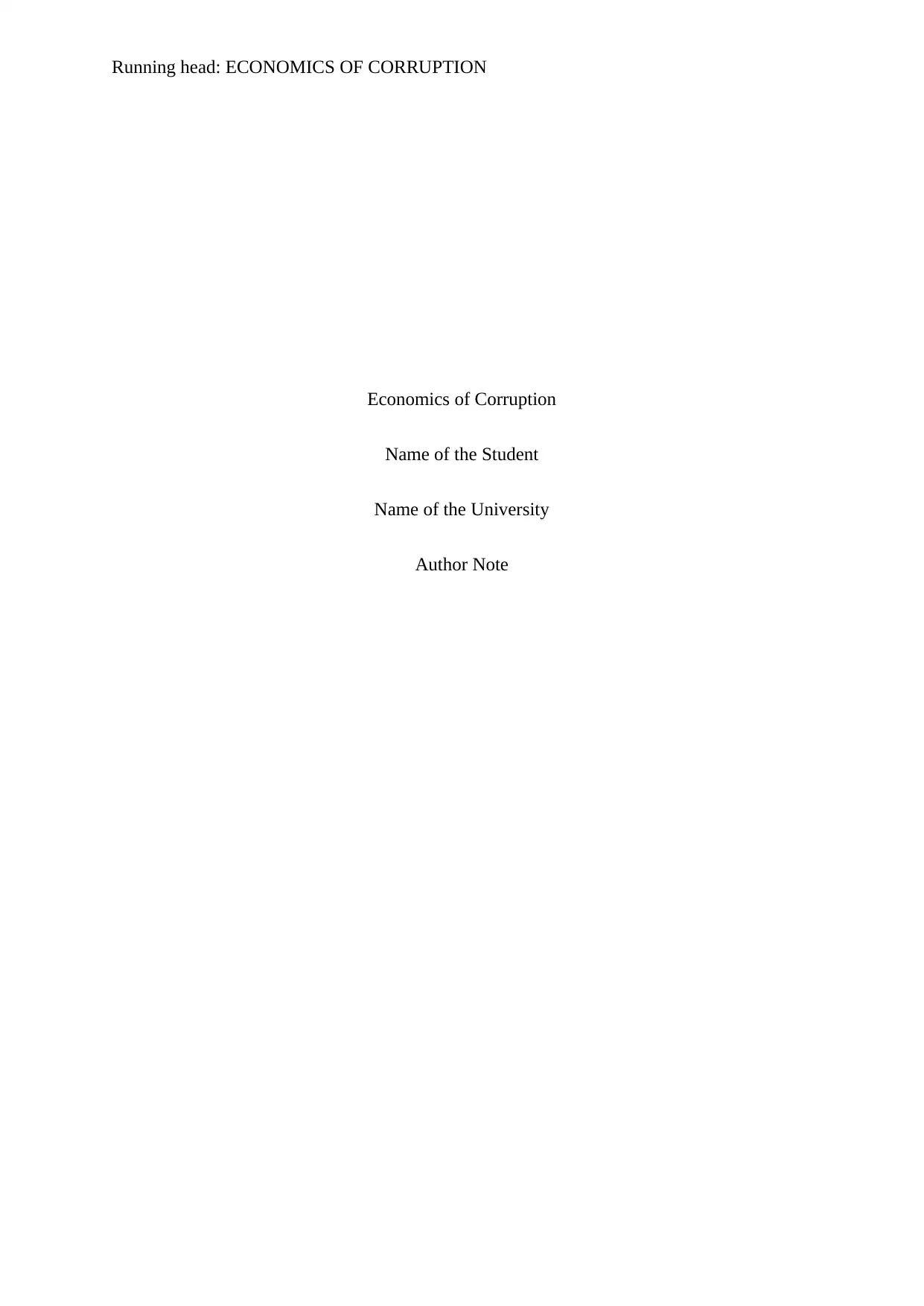
Running head: ECONOMICS OF CORRUPTION
Economics of Corruption
Name of the Student
Name of the University
Author Note
Economics of Corruption
Name of the Student
Name of the University
Author Note
Paraphrase This Document
Need a fresh take? Get an instant paraphrase of this document with our AI Paraphraser
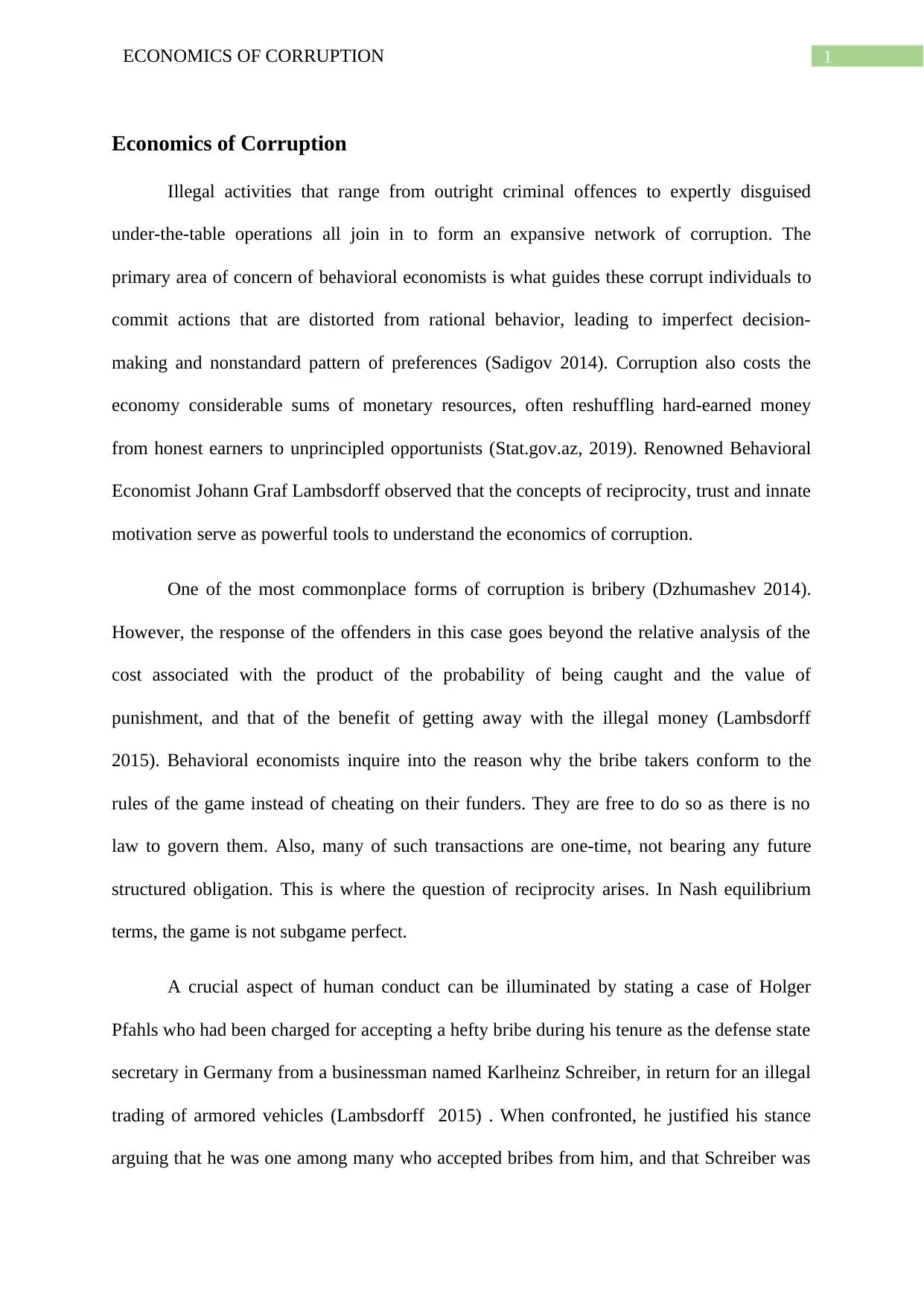
1ECONOMICS OF CORRUPTION
Economics of Corruption
Illegal activities that range from outright criminal offences to expertly disguised
under-the-table operations all join in to form an expansive network of corruption. The
primary area of concern of behavioral economists is what guides these corrupt individuals to
commit actions that are distorted from rational behavior, leading to imperfect decision-
making and nonstandard pattern of preferences (Sadigov 2014). Corruption also costs the
economy considerable sums of monetary resources, often reshuffling hard-earned money
from honest earners to unprincipled opportunists (Stat.gov.az, 2019). Renowned Behavioral
Economist Johann Graf Lambsdorff observed that the concepts of reciprocity, trust and innate
motivation serve as powerful tools to understand the economics of corruption.
One of the most commonplace forms of corruption is bribery (Dzhumashev 2014).
However, the response of the offenders in this case goes beyond the relative analysis of the
cost associated with the product of the probability of being caught and the value of
punishment, and that of the benefit of getting away with the illegal money (Lambsdorff
2015). Behavioral economists inquire into the reason why the bribe takers conform to the
rules of the game instead of cheating on their funders. They are free to do so as there is no
law to govern them. Also, many of such transactions are one-time, not bearing any future
structured obligation. This is where the question of reciprocity arises. In Nash equilibrium
terms, the game is not subgame perfect.
A crucial aspect of human conduct can be illuminated by stating a case of Holger
Pfahls who had been charged for accepting a hefty bribe during his tenure as the defense state
secretary in Germany from a businessman named Karlheinz Schreiber, in return for an illegal
trading of armored vehicles (Lambsdorff 2015) . When confronted, he justified his stance
arguing that he was one among many who accepted bribes from him, and that Schreiber was
Economics of Corruption
Illegal activities that range from outright criminal offences to expertly disguised
under-the-table operations all join in to form an expansive network of corruption. The
primary area of concern of behavioral economists is what guides these corrupt individuals to
commit actions that are distorted from rational behavior, leading to imperfect decision-
making and nonstandard pattern of preferences (Sadigov 2014). Corruption also costs the
economy considerable sums of monetary resources, often reshuffling hard-earned money
from honest earners to unprincipled opportunists (Stat.gov.az, 2019). Renowned Behavioral
Economist Johann Graf Lambsdorff observed that the concepts of reciprocity, trust and innate
motivation serve as powerful tools to understand the economics of corruption.
One of the most commonplace forms of corruption is bribery (Dzhumashev 2014).
However, the response of the offenders in this case goes beyond the relative analysis of the
cost associated with the product of the probability of being caught and the value of
punishment, and that of the benefit of getting away with the illegal money (Lambsdorff
2015). Behavioral economists inquire into the reason why the bribe takers conform to the
rules of the game instead of cheating on their funders. They are free to do so as there is no
law to govern them. Also, many of such transactions are one-time, not bearing any future
structured obligation. This is where the question of reciprocity arises. In Nash equilibrium
terms, the game is not subgame perfect.
A crucial aspect of human conduct can be illuminated by stating a case of Holger
Pfahls who had been charged for accepting a hefty bribe during his tenure as the defense state
secretary in Germany from a businessman named Karlheinz Schreiber, in return for an illegal
trading of armored vehicles (Lambsdorff 2015) . When confronted, he justified his stance
arguing that he was one among many who accepted bribes from him, and that Schreiber was
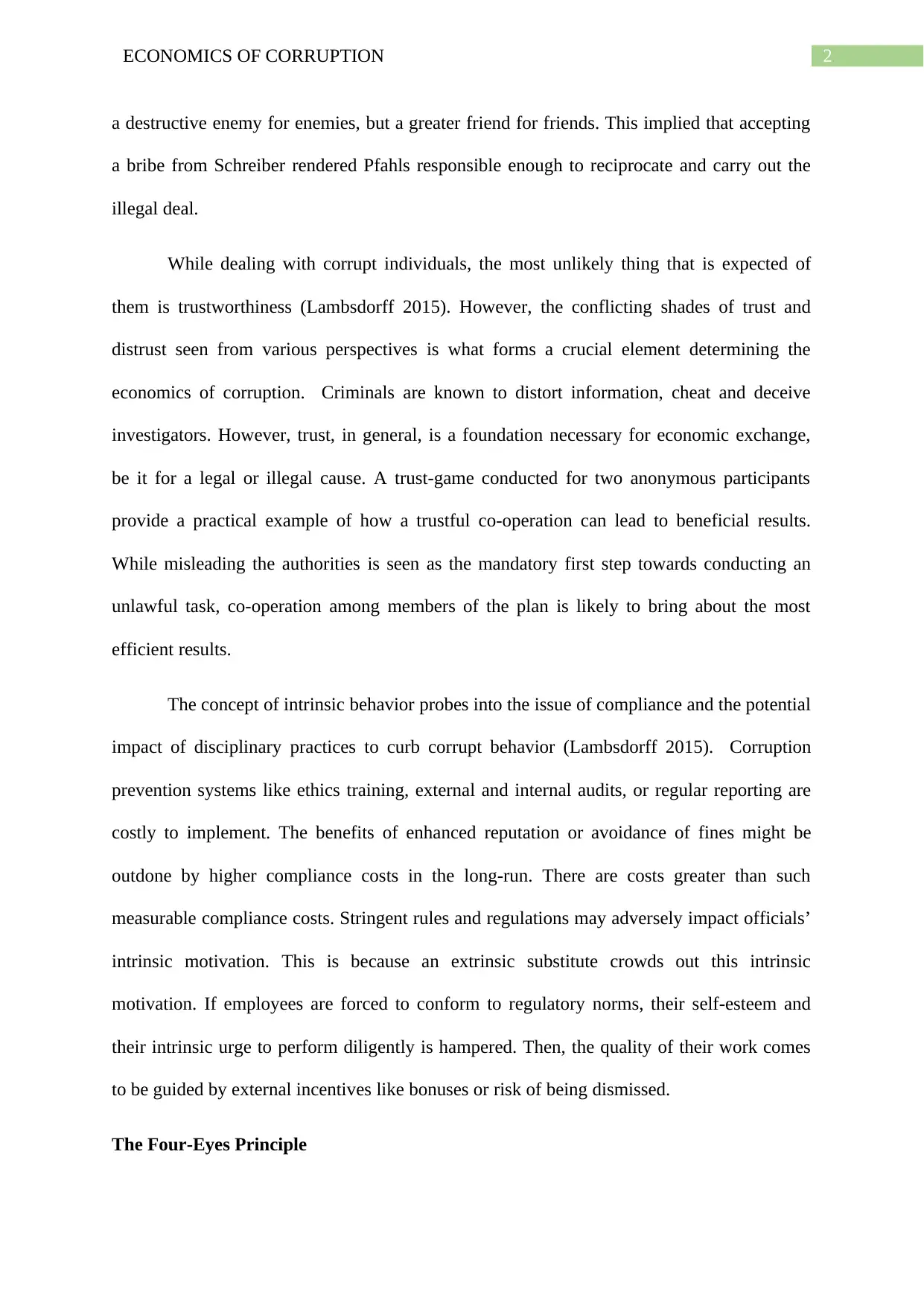
2ECONOMICS OF CORRUPTION
a destructive enemy for enemies, but a greater friend for friends. This implied that accepting
a bribe from Schreiber rendered Pfahls responsible enough to reciprocate and carry out the
illegal deal.
While dealing with corrupt individuals, the most unlikely thing that is expected of
them is trustworthiness (Lambsdorff 2015). However, the conflicting shades of trust and
distrust seen from various perspectives is what forms a crucial element determining the
economics of corruption. Criminals are known to distort information, cheat and deceive
investigators. However, trust, in general, is a foundation necessary for economic exchange,
be it for a legal or illegal cause. A trust-game conducted for two anonymous participants
provide a practical example of how a trustful co-operation can lead to beneficial results.
While misleading the authorities is seen as the mandatory first step towards conducting an
unlawful task, co-operation among members of the plan is likely to bring about the most
efficient results.
The concept of intrinsic behavior probes into the issue of compliance and the potential
impact of disciplinary practices to curb corrupt behavior (Lambsdorff 2015). Corruption
prevention systems like ethics training, external and internal audits, or regular reporting are
costly to implement. The benefits of enhanced reputation or avoidance of fines might be
outdone by higher compliance costs in the long-run. There are costs greater than such
measurable compliance costs. Stringent rules and regulations may adversely impact officials’
intrinsic motivation. This is because an extrinsic substitute crowds out this intrinsic
motivation. If employees are forced to conform to regulatory norms, their self-esteem and
their intrinsic urge to perform diligently is hampered. Then, the quality of their work comes
to be guided by external incentives like bonuses or risk of being dismissed.
The Four-Eyes Principle
a destructive enemy for enemies, but a greater friend for friends. This implied that accepting
a bribe from Schreiber rendered Pfahls responsible enough to reciprocate and carry out the
illegal deal.
While dealing with corrupt individuals, the most unlikely thing that is expected of
them is trustworthiness (Lambsdorff 2015). However, the conflicting shades of trust and
distrust seen from various perspectives is what forms a crucial element determining the
economics of corruption. Criminals are known to distort information, cheat and deceive
investigators. However, trust, in general, is a foundation necessary for economic exchange,
be it for a legal or illegal cause. A trust-game conducted for two anonymous participants
provide a practical example of how a trustful co-operation can lead to beneficial results.
While misleading the authorities is seen as the mandatory first step towards conducting an
unlawful task, co-operation among members of the plan is likely to bring about the most
efficient results.
The concept of intrinsic behavior probes into the issue of compliance and the potential
impact of disciplinary practices to curb corrupt behavior (Lambsdorff 2015). Corruption
prevention systems like ethics training, external and internal audits, or regular reporting are
costly to implement. The benefits of enhanced reputation or avoidance of fines might be
outdone by higher compliance costs in the long-run. There are costs greater than such
measurable compliance costs. Stringent rules and regulations may adversely impact officials’
intrinsic motivation. This is because an extrinsic substitute crowds out this intrinsic
motivation. If employees are forced to conform to regulatory norms, their self-esteem and
their intrinsic urge to perform diligently is hampered. Then, the quality of their work comes
to be guided by external incentives like bonuses or risk of being dismissed.
The Four-Eyes Principle
⊘ This is a preview!⊘
Do you want full access?
Subscribe today to unlock all pages.

Trusted by 1+ million students worldwide
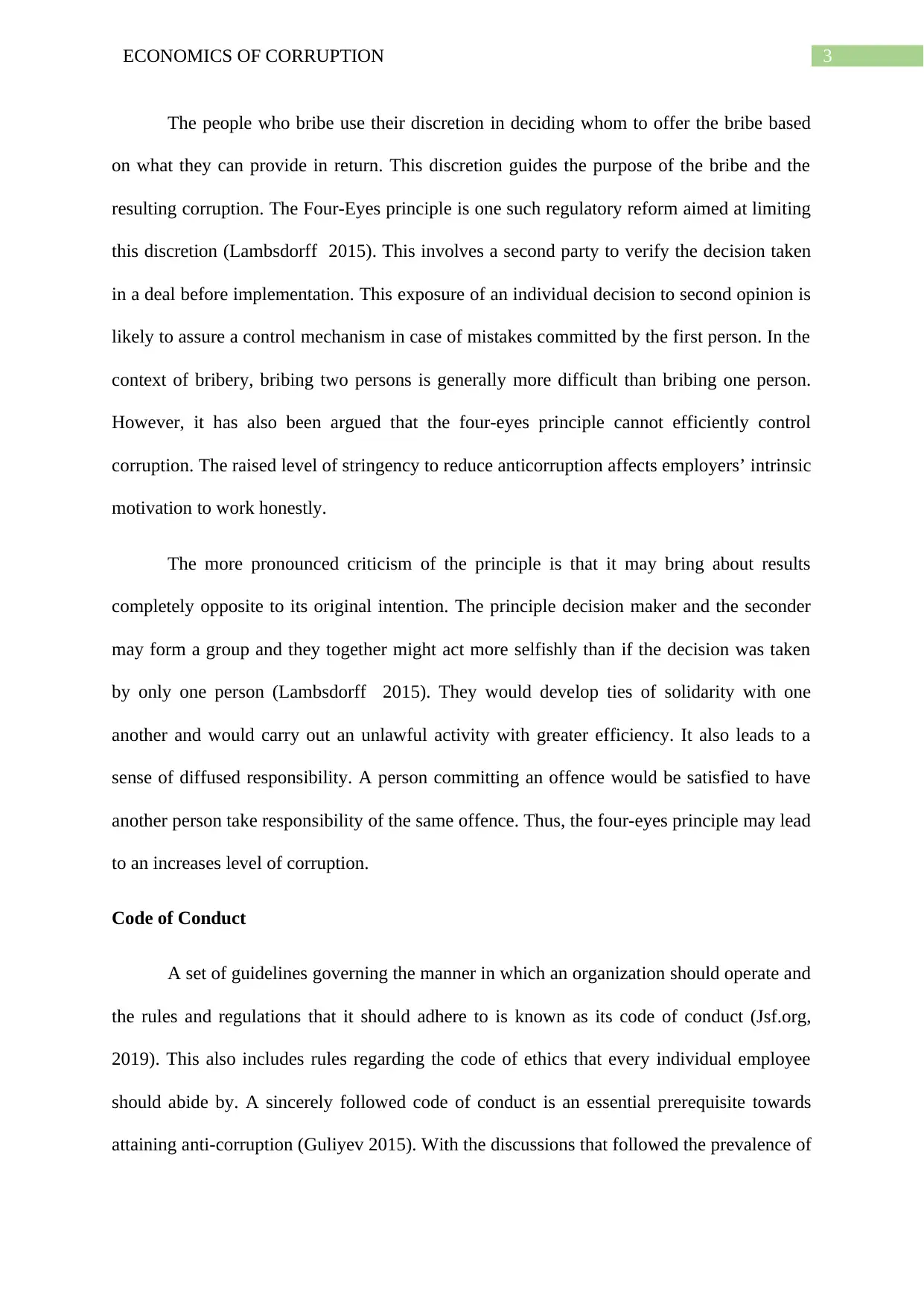
3ECONOMICS OF CORRUPTION
The people who bribe use their discretion in deciding whom to offer the bribe based
on what they can provide in return. This discretion guides the purpose of the bribe and the
resulting corruption. The Four-Eyes principle is one such regulatory reform aimed at limiting
this discretion (Lambsdorff 2015). This involves a second party to verify the decision taken
in a deal before implementation. This exposure of an individual decision to second opinion is
likely to assure a control mechanism in case of mistakes committed by the first person. In the
context of bribery, bribing two persons is generally more difficult than bribing one person.
However, it has also been argued that the four-eyes principle cannot efficiently control
corruption. The raised level of stringency to reduce anticorruption affects employers’ intrinsic
motivation to work honestly.
The more pronounced criticism of the principle is that it may bring about results
completely opposite to its original intention. The principle decision maker and the seconder
may form a group and they together might act more selfishly than if the decision was taken
by only one person (Lambsdorff 2015). They would develop ties of solidarity with one
another and would carry out an unlawful activity with greater efficiency. It also leads to a
sense of diffused responsibility. A person committing an offence would be satisfied to have
another person take responsibility of the same offence. Thus, the four-eyes principle may lead
to an increases level of corruption.
Code of Conduct
A set of guidelines governing the manner in which an organization should operate and
the rules and regulations that it should adhere to is known as its code of conduct (Jsf.org,
2019). This also includes rules regarding the code of ethics that every individual employee
should abide by. A sincerely followed code of conduct is an essential prerequisite towards
attaining anti-corruption (Guliyev 2015). With the discussions that followed the prevalence of
The people who bribe use their discretion in deciding whom to offer the bribe based
on what they can provide in return. This discretion guides the purpose of the bribe and the
resulting corruption. The Four-Eyes principle is one such regulatory reform aimed at limiting
this discretion (Lambsdorff 2015). This involves a second party to verify the decision taken
in a deal before implementation. This exposure of an individual decision to second opinion is
likely to assure a control mechanism in case of mistakes committed by the first person. In the
context of bribery, bribing two persons is generally more difficult than bribing one person.
However, it has also been argued that the four-eyes principle cannot efficiently control
corruption. The raised level of stringency to reduce anticorruption affects employers’ intrinsic
motivation to work honestly.
The more pronounced criticism of the principle is that it may bring about results
completely opposite to its original intention. The principle decision maker and the seconder
may form a group and they together might act more selfishly than if the decision was taken
by only one person (Lambsdorff 2015). They would develop ties of solidarity with one
another and would carry out an unlawful activity with greater efficiency. It also leads to a
sense of diffused responsibility. A person committing an offence would be satisfied to have
another person take responsibility of the same offence. Thus, the four-eyes principle may lead
to an increases level of corruption.
Code of Conduct
A set of guidelines governing the manner in which an organization should operate and
the rules and regulations that it should adhere to is known as its code of conduct (Jsf.org,
2019). This also includes rules regarding the code of ethics that every individual employee
should abide by. A sincerely followed code of conduct is an essential prerequisite towards
attaining anti-corruption (Guliyev 2015). With the discussions that followed the prevalence of
Paraphrase This Document
Need a fresh take? Get an instant paraphrase of this document with our AI Paraphraser

4ECONOMICS OF CORRUPTION
intrinsic behavior, ways should be convened in already diligent employees are not made to be
demotivated while an attempt is made to reduce instances of corruption. However, the code
of conduct alone cannot suffice (Mallin and Zattoni 2016). The anti-corruption system of
which it is a part should take into consideration the main risks associated with corruption
including geographical, social and financial factors.
International anti-corruption bodies like United Nations Convention Against
Corruption have a practice of imposing liability on legal people for their corrupt practices.
This is also done by OECD’s Convention on Anti-Bribery. A company’s code of ethics
should contain a comprehensive segment on risk assessment (Escresa and Picci 2017).
Azerbaijan Rules
Azerbaijan has a well-defined set of guidelines governing abuse of official powers (Chayes
2016). Section 308 of the chapter on offences of corruption states that if official powers are
deliberately abused, going against service interest and also posing a threat to the interests of
the citizens and the society, it may attract a penalty of as much as two thousand Azerbaijani
Manats (Qian and Sandoval-Hernandez 2016). The punishment may, as an alternative,
involve a two years’ worth of restorative work, or indulgence in public works for as many as
two hundred hours (Oecd.org, 2019).
As per section 311, the receipt of bribes by an official, be it direct or otherwise,
personal or involving an intermediary, irrespective of the material involved in the act, would
impose upon the offender an imprisonment ranging from 4 to 8 years as well as confiscation
of goods and property (Commission-anticorruption.gov.az, 2019). If such a bribe is received
for an illegal activity, the receiver would be faced with imprisonment for as many as 5 to 10
years. He would also be denied the right to hold specific positions or engage himself in some
activities for a time period of up to 3 years, apart from appropriation of his property.
intrinsic behavior, ways should be convened in already diligent employees are not made to be
demotivated while an attempt is made to reduce instances of corruption. However, the code
of conduct alone cannot suffice (Mallin and Zattoni 2016). The anti-corruption system of
which it is a part should take into consideration the main risks associated with corruption
including geographical, social and financial factors.
International anti-corruption bodies like United Nations Convention Against
Corruption have a practice of imposing liability on legal people for their corrupt practices.
This is also done by OECD’s Convention on Anti-Bribery. A company’s code of ethics
should contain a comprehensive segment on risk assessment (Escresa and Picci 2017).
Azerbaijan Rules
Azerbaijan has a well-defined set of guidelines governing abuse of official powers (Chayes
2016). Section 308 of the chapter on offences of corruption states that if official powers are
deliberately abused, going against service interest and also posing a threat to the interests of
the citizens and the society, it may attract a penalty of as much as two thousand Azerbaijani
Manats (Qian and Sandoval-Hernandez 2016). The punishment may, as an alternative,
involve a two years’ worth of restorative work, or indulgence in public works for as many as
two hundred hours (Oecd.org, 2019).
As per section 311, the receipt of bribes by an official, be it direct or otherwise,
personal or involving an intermediary, irrespective of the material involved in the act, would
impose upon the offender an imprisonment ranging from 4 to 8 years as well as confiscation
of goods and property (Commission-anticorruption.gov.az, 2019). If such a bribe is received
for an illegal activity, the receiver would be faced with imprisonment for as many as 5 to 10
years. He would also be denied the right to hold specific positions or engage himself in some
activities for a time period of up to 3 years, apart from appropriation of his property.

5ECONOMICS OF CORRUPTION
If the aforementioned two patterns of bribery are committed in an organized manner
as per arrangements made by a group, or if they committed repeatedly or involve huge sums
of money and if they involve threatening other parties, the offenders would be imprisoned for
as many as 8 to 12 years, apart from property confiscation as before (Commission-
anticorruption.gov.az, 2019). The act of giving bribes, be it directly or indirectly, personally
or with the aid of an intermediary would also attract fines of 1000 or 2000 Azerbaijani
Manats, or an imprisonment term of 4, 5, or 8 years, apart from appropriation of property
(Commission-anticorruption.gov.az, 2019). The person offering the bribe would be released
of criminal offense if it is found that he was coerced to do so under the threat of an external
factor or he voluntarily made the confession about the bribe to a state authority.
Penalties would also be charged on those individuals or groups who attempt to sneak
in false data in official records, or try to distort already existing data for personal gain or
other interests. It would charge him 500 to 1000 Manats or would requires him to engage in
correctional measures for 1 to 2 years (Stat.gov.az, 2019).
Corrective Measures
A strict and regularly revised system of preventive measures should be in operation.
Leniency with regards implementation of code of conduct or a lukewarm enquiry into
whether the company reforms are being adhered to is likely to make the employees take these
rules for granted, providing the opportunity for the disloyal workers to easily ignore the
company norms (Bussmann and Niemeczek 2017).
On the other hand, a particular concern should be provided to the prevalence of
intrinsic behavior, in order to not make the stringent rules result in loyal employees losing
their self-esteem because they may see these extra rules as an insult to the already diligent
work they propose to deliver. To maintain balance, then, instead of extreme policies that may
If the aforementioned two patterns of bribery are committed in an organized manner
as per arrangements made by a group, or if they committed repeatedly or involve huge sums
of money and if they involve threatening other parties, the offenders would be imprisoned for
as many as 8 to 12 years, apart from property confiscation as before (Commission-
anticorruption.gov.az, 2019). The act of giving bribes, be it directly or indirectly, personally
or with the aid of an intermediary would also attract fines of 1000 or 2000 Azerbaijani
Manats, or an imprisonment term of 4, 5, or 8 years, apart from appropriation of property
(Commission-anticorruption.gov.az, 2019). The person offering the bribe would be released
of criminal offense if it is found that he was coerced to do so under the threat of an external
factor or he voluntarily made the confession about the bribe to a state authority.
Penalties would also be charged on those individuals or groups who attempt to sneak
in false data in official records, or try to distort already existing data for personal gain or
other interests. It would charge him 500 to 1000 Manats or would requires him to engage in
correctional measures for 1 to 2 years (Stat.gov.az, 2019).
Corrective Measures
A strict and regularly revised system of preventive measures should be in operation.
Leniency with regards implementation of code of conduct or a lukewarm enquiry into
whether the company reforms are being adhered to is likely to make the employees take these
rules for granted, providing the opportunity for the disloyal workers to easily ignore the
company norms (Bussmann and Niemeczek 2017).
On the other hand, a particular concern should be provided to the prevalence of
intrinsic behavior, in order to not make the stringent rules result in loyal employees losing
their self-esteem because they may see these extra rules as an insult to the already diligent
work they propose to deliver. To maintain balance, then, instead of extreme policies that may
⊘ This is a preview!⊘
Do you want full access?
Subscribe today to unlock all pages.

Trusted by 1+ million students worldwide
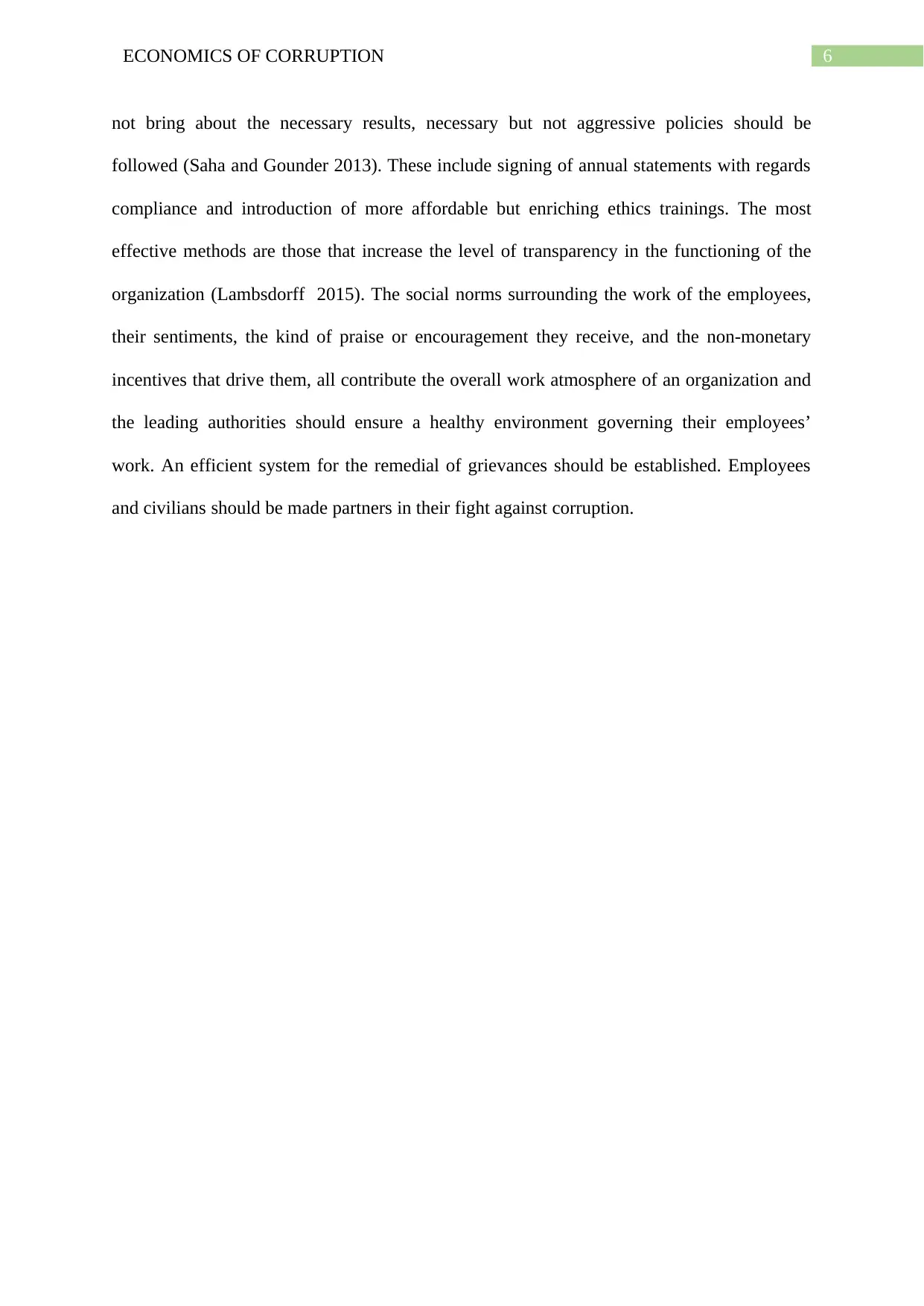
6ECONOMICS OF CORRUPTION
not bring about the necessary results, necessary but not aggressive policies should be
followed (Saha and Gounder 2013). These include signing of annual statements with regards
compliance and introduction of more affordable but enriching ethics trainings. The most
effective methods are those that increase the level of transparency in the functioning of the
organization (Lambsdorff 2015). The social norms surrounding the work of the employees,
their sentiments, the kind of praise or encouragement they receive, and the non-monetary
incentives that drive them, all contribute the overall work atmosphere of an organization and
the leading authorities should ensure a healthy environment governing their employees’
work. An efficient system for the remedial of grievances should be established. Employees
and civilians should be made partners in their fight against corruption.
not bring about the necessary results, necessary but not aggressive policies should be
followed (Saha and Gounder 2013). These include signing of annual statements with regards
compliance and introduction of more affordable but enriching ethics trainings. The most
effective methods are those that increase the level of transparency in the functioning of the
organization (Lambsdorff 2015). The social norms surrounding the work of the employees,
their sentiments, the kind of praise or encouragement they receive, and the non-monetary
incentives that drive them, all contribute the overall work atmosphere of an organization and
the leading authorities should ensure a healthy environment governing their employees’
work. An efficient system for the remedial of grievances should be established. Employees
and civilians should be made partners in their fight against corruption.
Paraphrase This Document
Need a fresh take? Get an instant paraphrase of this document with our AI Paraphraser
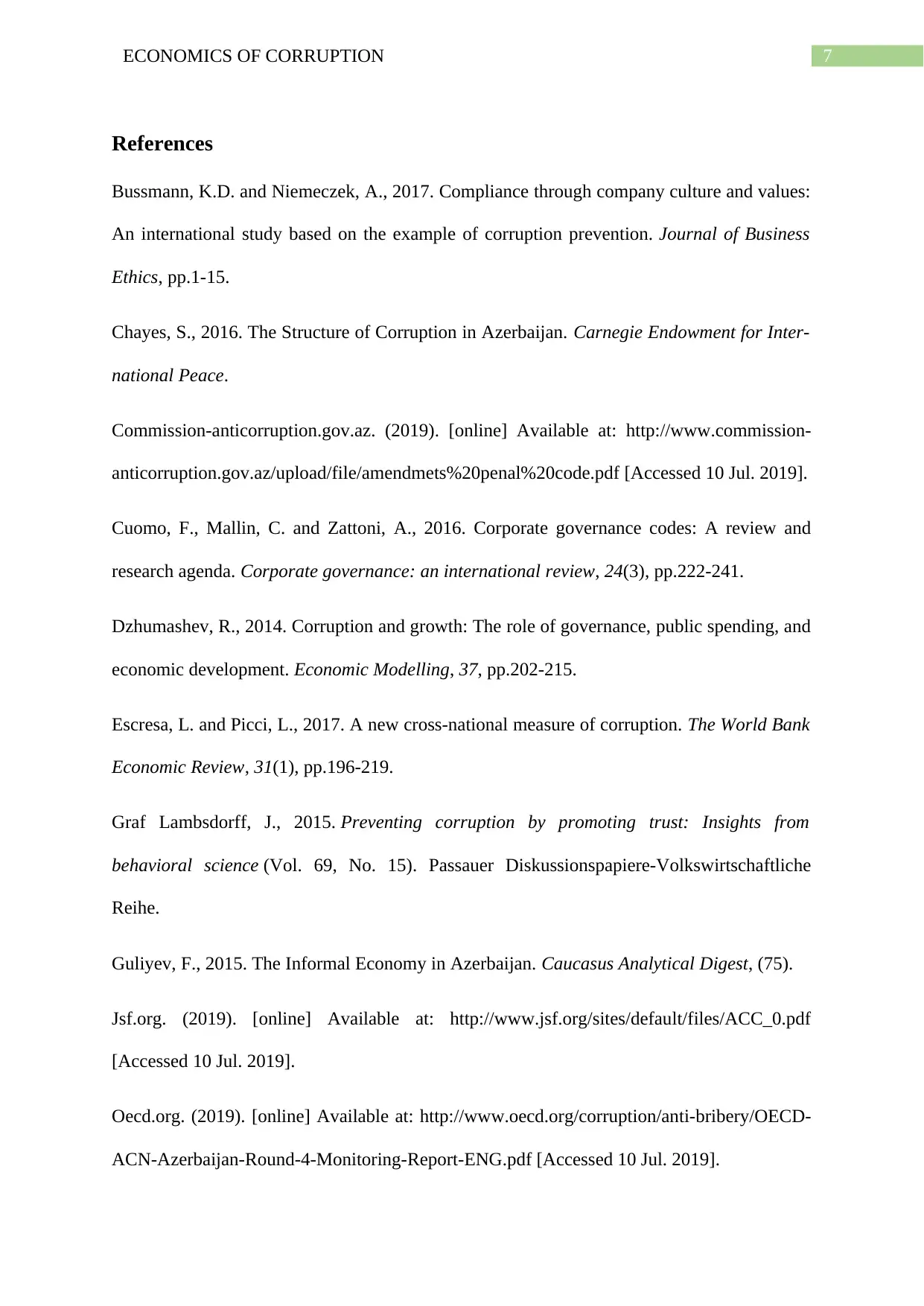
7ECONOMICS OF CORRUPTION
References
Bussmann, K.D. and Niemeczek, A., 2017. Compliance through company culture and values:
An international study based on the example of corruption prevention. Journal of Business
Ethics, pp.1-15.
Chayes, S., 2016. The Structure of Corruption in Azerbaijan. Carnegie Endowment for Inter-
national Peace.
Commission-anticorruption.gov.az. (2019). [online] Available at: http://www.commission-
anticorruption.gov.az/upload/file/amendmets%20penal%20code.pdf [Accessed 10 Jul. 2019].
Cuomo, F., Mallin, C. and Zattoni, A., 2016. Corporate governance codes: A review and
research agenda. Corporate governance: an international review, 24(3), pp.222-241.
Dzhumashev, R., 2014. Corruption and growth: The role of governance, public spending, and
economic development. Economic Modelling, 37, pp.202-215.
Escresa, L. and Picci, L., 2017. A new cross-national measure of corruption. The World Bank
Economic Review, 31(1), pp.196-219.
Graf Lambsdorff, J., 2015. Preventing corruption by promoting trust: Insights from
behavioral science (Vol. 69, No. 15). Passauer Diskussionspapiere-Volkswirtschaftliche
Reihe.
Guliyev, F., 2015. The Informal Economy in Azerbaijan. Caucasus Analytical Digest, (75).
Jsf.org. (2019). [online] Available at: http://www.jsf.org/sites/default/files/ACC_0.pdf
[Accessed 10 Jul. 2019].
Oecd.org. (2019). [online] Available at: http://www.oecd.org/corruption/anti-bribery/OECD-
ACN-Azerbaijan-Round-4-Monitoring-Report-ENG.pdf [Accessed 10 Jul. 2019].
References
Bussmann, K.D. and Niemeczek, A., 2017. Compliance through company culture and values:
An international study based on the example of corruption prevention. Journal of Business
Ethics, pp.1-15.
Chayes, S., 2016. The Structure of Corruption in Azerbaijan. Carnegie Endowment for Inter-
national Peace.
Commission-anticorruption.gov.az. (2019). [online] Available at: http://www.commission-
anticorruption.gov.az/upload/file/amendmets%20penal%20code.pdf [Accessed 10 Jul. 2019].
Cuomo, F., Mallin, C. and Zattoni, A., 2016. Corporate governance codes: A review and
research agenda. Corporate governance: an international review, 24(3), pp.222-241.
Dzhumashev, R., 2014. Corruption and growth: The role of governance, public spending, and
economic development. Economic Modelling, 37, pp.202-215.
Escresa, L. and Picci, L., 2017. A new cross-national measure of corruption. The World Bank
Economic Review, 31(1), pp.196-219.
Graf Lambsdorff, J., 2015. Preventing corruption by promoting trust: Insights from
behavioral science (Vol. 69, No. 15). Passauer Diskussionspapiere-Volkswirtschaftliche
Reihe.
Guliyev, F., 2015. The Informal Economy in Azerbaijan. Caucasus Analytical Digest, (75).
Jsf.org. (2019). [online] Available at: http://www.jsf.org/sites/default/files/ACC_0.pdf
[Accessed 10 Jul. 2019].
Oecd.org. (2019). [online] Available at: http://www.oecd.org/corruption/anti-bribery/OECD-
ACN-Azerbaijan-Round-4-Monitoring-Report-ENG.pdf [Accessed 10 Jul. 2019].

8ECONOMICS OF CORRUPTION
Qian, X. and Sandoval-Hernandez, J., 2016. Corruption distance and foreign direct
investment. Emerging Markets Finance and Trade, 52(2), pp.400-419.
Sadigov, T., 2014. Corruption and social responsibility: bribe offers among small
entrepreneurs in Azerbaijan. East European Politics, 30(1), pp.34-53.
Saha, S. and Gounder, R., 2013. Corruption and economic development nexus: Variations
across income levels in a non-linear framework. Economic Modelling, 31, pp.70-79.
Stat.gov.az. (2019). [online] Available at:
https://www.stat.gov.az/menu/3/Legislation/corruption_en.pdf [Accessed 10 Jul. 2019].
Qian, X. and Sandoval-Hernandez, J., 2016. Corruption distance and foreign direct
investment. Emerging Markets Finance and Trade, 52(2), pp.400-419.
Sadigov, T., 2014. Corruption and social responsibility: bribe offers among small
entrepreneurs in Azerbaijan. East European Politics, 30(1), pp.34-53.
Saha, S. and Gounder, R., 2013. Corruption and economic development nexus: Variations
across income levels in a non-linear framework. Economic Modelling, 31, pp.70-79.
Stat.gov.az. (2019). [online] Available at:
https://www.stat.gov.az/menu/3/Legislation/corruption_en.pdf [Accessed 10 Jul. 2019].
⊘ This is a preview!⊘
Do you want full access?
Subscribe today to unlock all pages.

Trusted by 1+ million students worldwide
1 out of 9
Your All-in-One AI-Powered Toolkit for Academic Success.
+13062052269
info@desklib.com
Available 24*7 on WhatsApp / Email
![[object Object]](/_next/static/media/star-bottom.7253800d.svg)
Unlock your academic potential
Copyright © 2020–2025 A2Z Services. All Rights Reserved. Developed and managed by ZUCOL.